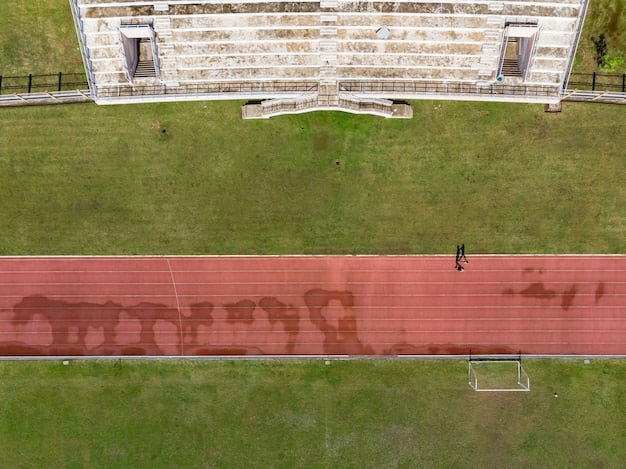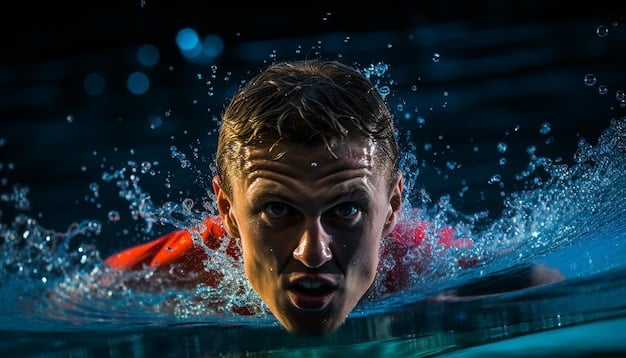Olympic athletes’ top 5 underrated techniques to boost performance by 15%

Uncovering how Olympic athletes achieve peak performance, this article delves into five often-overlooked training techniques that can significantly enhance athletic prowess, offering insights beyond conventional methods.
In the pursuit of athletic excellence, the world of Olympic sports often seems to unveil its secrets through grueling routines and state-of-the-art facilities. Yet, beneath the surface of well-publicized training regimens lie less-touted, but immensely powerful, techniques. This article explores what are the top 5 underrated training techniques used by Olympic athletes to increase performance by 15%, offering a deeper understanding of the marginal gains that separate champions from competitors.
The overlooked power of periodization and strategic deloads
Periodization is a fundamental concept in exercise science, yet its nuanced application, particularly concerning strategic deloads, is often underestimated in its impact on Olympic-level performance. It’s not just about planning cycles; it’s about the intricate dance between stress and recovery, pushing the body to adapt while preventing overtraining and burnout.
Many athletes and coaches understand the general principle of periodization – varying training intensity and volume over time to optimize performance for specific events. However, the true mastery lies in the precise timing and execution of deload weeks or microcycles. These controlled reduction periods in training volume and intensity are critical. They allow the body to fully recover, repair tissues, and consolidate adaptations without losing fitness gains. Olympic athletes often integrate active recovery and cross-training during these phases, ensuring continued, albeit lighter, physiological engagement. The benefit is not just physical; it’s also psychological, offering a mental break that can reignite motivation and focus for subsequent intense training blocks.
Optimizing the recovery window
The traditional view of recovery often focuses solely on rest days. However, elite athletes leverage very specific types of recovery within their deload periods. This includes not just passive rest but active recovery, such as light aerobic work or mobility exercises, which aid in blood flow and waste removal.
* **Active Recovery:** Gentle movement to facilitate lactic acid removal and reduce muscle soreness.
* **Nutritional Timing:** Strategic intake of micronutrients and macronutrients during deloads to optimize tissue repair and replenish glycogen stores.
* **Sleep Optimization:** Prioritizing deep, consistent sleep cycles as a non-negotiable component of recovery.
* **Mental Detachment:** Engaging in activities entirely unrelated to their sport to provide psychological rejuvenation.
The careful calibration of deloads within a broader periodization scheme prevents the cumulative fatigue that can lead to performance plateaus or, worse, injury. For an Olympic athlete, a 15% improvement is often the result of not just harder training, but smarter training, with deloads playing an integral, albeit often unsung, role in their overall long-term development and peak performance on competition day. Regular assessment of an athlete’s physiological and psychological state guides these adjustments, moving beyond rigid schedules to a more responsive, individualized approach. The goal is always to approach the peak performance window refreshed, resilient, and ready to execute.
Neuromuscular potentiation through post-activation performance enhancement (PAPE)
While many athletes focus on strength and conditioning, the intricate science of neuromuscular potentiation, particularly through Post-Activation Performance Enhancement (PAPE), remains largely underrated outside elite circles. PAPE refers to the phenomenon where muscle force and power output are acutely increased following a conditioning activity. This isn’t just a warm-up; it’s a strategically designed activation sequence immediately before a high-intensity movement or competition.
Olympic athletes often incorporate specific, heavy lifts or isometric holds shortly before their primary event. For example, a sprinter might perform a few maximal effort squats or a power clean before their race. The key is that the conditioning activity should be intense enough to elicit a potentiation effect, but brief enough not to induce significant fatigue. This primes the nervous system, increasing motor unit excitability and muscle fiber recruitment, leading to a temporary but significant boost in power and speed. The magnitude of this effect can vary greatly depending on the individual, the sport, and the specific PAPE protocol used, making its application a highly personalized art.
Tailored PAPE protocols
The effectiveness of PAPE lies in its specificity and individualization. What works for a weightlifter might not be optimal for a swimmer. Elite coaches spend considerable time experimenting with different exercises, intensities, and rest periods to find the perfect PAPE strategy for each athlete.
* **Exercise Selection:** Choosing movements that are biomechanically similar to the athlete’s primary competitive movement.
* **Intensity & Volume:** Finding the delicate balance between sufficient stimulus and excessive fatigue.
* **Rest Intervals:** Determining the optimal recovery period between the conditioning activity and the performance task to maximize potentiation.
The beauty of PAPE is its immediate impact. It leverages the body’s natural physiological responses to acute stress, turning it into instantaneous power. A 15% increase in a jump height, sprint speed, or throwing velocity due to enhanced neuromuscular efficiency can be the difference between a medal and an honorable mention. This technique requires meticulous planning and a deep understanding of the athlete’s physiology, as well as the demands of their specific sport. It’s often imperceptible to the casual observer, yet it consistently delivers measurable improvements in explosive power when applied correctly by Olympic-level competitors.
The art of focused attention training and visualization
Beyond the physical grind, the mental game is a colossal factor in Olympic success. While sports psychology is recognized, the specific, highly refined techniques of focused attention training and nuanced visualization are still profoundly underrated. These aren’t just feel-good exercises; they are rigorous cognitive practices designed to optimize an athlete’s mental state and motor performance under pressure, contributing significantly to performance gains that can reach into double digits.
Focused attention training involves cultivating the ability to direct and sustain attention on a specific task or cue, especially amidst distractions. For an Olympic athlete, this might mean intensely concentrating on the feel of the water in a swim stroke, the perfect angle of a pole vault takeoff, or the subtle shift of balance during a gymnastic routine. It’s about minimizing internal chatter and external noise, ensuring that every movement is executed with precise, conscious intent. This level of presence in the moment helps to reduce errors and optimize efficiency, making every action count. It’s a skill honed through consistent practice, much like physical training, and can dramatically improve execution consistency, particularly when fatigue sets in or stakes are high.

Advanced visualization techniques
Visualization goes far beyond simply imagining success. Elite athletes engage in “multi-sensory” or “kinesthetic” visualization, where they not only see the perfect performance but also feel it, hear it, and even smell elements of the environment.
* **Kinesthetic Imagery:** Feeling the muscles engage, the pressure on the feet, or the air resistance.
* **Auditory Cues:** Hearing the crowd, the crack of a pistol, or the splash of water.
* **Process-Oriented Visualization:** Focusing on the execution of each technical component rather than just the outcome.
* **Coping Imagery:** Visualizing overcoming potential obstacles or errors during competition.
This deep level of mental rehearsal imprints neural pathways, making the physical execution almost automatic under pressure. It builds confidence, reduces anxiety, and enhances motor program efficiency. When an athlete has mentally rehearsed every nuance of their performance hundreds of times, their body is better prepared to perform flawlessly when the actual moment arrives. This cognitive training can subtly yet profoundly enhance reaction times, decision-making, and technical precision, delivering that crucial 15% edge that distinguishes medalists in high-stakes competition. The disciplined application of these techniques transforms mental fortitude from a desirable trait into a tangible performance enhancer.
Micro-dosing training loads and intelligent tapering strategies
In the relentless pursuit of peak performance, the conventional wisdom often emphasizes accumulating large volumes of high-intensity training. However, Olympic athletes are increasingly adopting a highly refined, yet underrated, approach: “micro-dosing” training loads combined with intelligent, highly individualized tapering strategies. This method diverges from traditional bulk training, focusing instead on precise, smaller doses of potent stimuli, interspersed with meticulous recovery, leading to enhanced adaptation and superior readiness for competition.
Micro-dosing involves breaking down what would typically be a single, long training session into several shorter, highly focused bursts spread throughout the day or week. For instance, rather than one arduous two-hour track session, a sprinter might do multiple 20-30 minute focused speed, strength, or technical sessions with ample recovery in between. This approach minimizes cumulative fatigue, allows for higher quality work per session, and keeps the athlete’s physiological systems more consistently primed. It leverages the body’s supercompensation curve more effectively, ensuring that each stimulus leads to an optimal adaptive response without dipping into the realm of overtraining. The emphasis shifts from duration to absolute quality and specific intent, fostering rapid skill acquisition and strength gains.
The science of tapering
Tapering, the strategic reduction in training volume and intensity before a major competition, is often seen as standard practice. However, “intelligent tapering” at the Olympic level is an art form backed by science, pushing beyond generic reductions to highly individualized, responsive protocols.
* **Progressive Volume Reduction:** Gradually decreasing training volume while maintaining or slightly increasing intensity to preserve adaptations.
* **Individualized Response:** Monitoring an athlete’s unique physiological markers (e.g., heart rate variability, sleep patterns, subjective well-being) to fine-tune the taper.
* **Maintaining Specificity:** Ensuring that reduced training still includes movements and energy systems directly relevant to competition.
The goal of this combined strategy is to arrive at competition optimally rested, fully adapted, and neurologically fresh. Micro-dosing prevents the deep fatigue that requires extensive recovery, making the final taper more effective in releasing accumulated fitness. This holistic approach, often invisible to onlookers, can unlock that crucial 15% performance uplift, allowing athletes to perform at their absolute peak when it matters most, fully expressing their built-up physical and technical capacities without the burden of residual fatigue. It represents a paradigm shift from ‘more is better’ to ‘smarter is faster and stronger.’
Embracing biofeedback training and real-time physiological monitoring
While wearable technology and data analytics are common in sports, Olympic athletes are pushing the boundaries with truly underrated techniques: sophisticated biofeedback training and real-time physiological monitoring. This goes beyond simply tracking heart rate or steps; it involves deeply understanding and consciously manipulating one’s own physiological responses, and reacting to granular, moment-to-moment data streams to optimize performance and recovery. This level of self-awareness and data-driven adaptation can yield significant performance increases, potentially contributing to that 15% edge.
Biofeedback training, in this context, refers to using real-time display of physiological data (like brainwaves, skin temperature, muscle tension, or heart rate variability) to gain conscious control over these usually involuntary processes. For an athlete, this might involve learning to reduce muscle tension during a dive, maintain optimal heart rate variability during rest periods, or enter a specific brainwave state for enhanced focus. It teaches the athlete to recognize internal signals and respond proactively, fostering a deeper mind-body connection. This skill is invaluable for managing pre-competition anxiety, optimizing arousal levels, and enhancing recovery between efforts. It transforms abstract physiological concepts into tangible, actionable insights an athlete can learn to control.

Advanced monitoring techniques
Real-time physiological monitoring is not just about collecting data; it’s about immediate interpretation and adaptive training adjustments. This includes:
* **Continuous Glucose Monitoring:** Optimizing fuel availability and recovery strategies by tracking real-time blood sugar levels.
* **Lactate Threshold On-the-Fly:** Adjusting training intensity during a session based on instantaneous lactate readings to stay within optimal zones.
* **Sleep Stage Tracking with Actionable Feedback:** Using detailed sleep data to adjust subsequent training loads and recovery protocols.
* **Neuromuscular Readiness Assessment:** Utilizing force plates or EMG sensors to gauge an athlete’s readiness for high-intensity work before a session.
The synergy between biofeedback and advanced monitoring creates a highly responsive training environment. Athletes and coaches can make instantaneous adjustments based on objective data and subjective self-awareness, preventing overtraining, optimizing recovery, and ensuring every training session serves its precise purpose. This granular, personalized approach to training and recovery is a critical, often unseen, determinant of Olympic success. It allows for performance optimization that far exceeds what general training prescriptions can achieve, providing the detailed insights needed to unlock an athlete’s full potential and secure significant gains.
Nutritional bio-individuality and gut health optimization
While sports nutrition is a well-established field, the truly underrated frontier for Olympic athletes lies in the granular understanding and manipulation of nutritional bio-individuality and the burgeoning science of gut health optimization. Moving beyond generic dietary guidelines, elite athletes are increasingly leveraging personalized nutritional strategies to unlock hidden performance gains and achieve significant improvements that could easily account for a 15% boost.
Nutritional bio-individuality acknowledges that each athlete’s body responds uniquely to different foods and macronutrient ratios based on genetics, metabolism, activity level, and gut microbiome composition. This means a diet optimized for one champion might be suboptimal for another. Olympic approaches often involve detailed metabolic testing, genetic profiling, and even advanced stool analyses to tailor dietary plans with extreme precision. For instance, some athletes might thrive on higher fat intake, while others perform best with higher carbohydrate loads, even within the same sport. This personalized approach often leads to optimized energy levels, reduced inflammation, faster recovery, and improved body composition, all of which directly translate into enhanced athletic output and resilience. It moves beyond “eating clean” to “eating right for my unique body.”
The gut-performance axis
The gut microbiome, an ecosystem of trillions of microorganisms in the digestive tract, is a relatively new but critical focus for elite athletes. Its influence extends far beyond digestion, impacting everything from nutrient absorption and immune function to inflammation and even mental clarity.
* **Probiotic and Prebiotic Supplementation:** Targeted use of specific strains and fibers to cultivate a diverse and healthy gut flora.
* **Dietary Fiber Modulation:** Adjusting complex carbohydrate and fiber intake to nourish beneficial gut bacteria.
* **Inflammatory Food Avoidance:** Identifying and eliminating foods that trigger gastrointestinal distress or systemic inflammation, often through trial-and-error guided by food sensitivity testing.
* **Hydration and Electrolyte Balance:** Ensuring optimal gut function through meticulous fluid and mineral intake.
By optimizing gut health, athletes can significantly enhance nutrient absorption, bolster their immune system (crucial for maintaining consistent training), and even improve mood and cognitive function. A healthy gut means more efficient energy production and less systemic stress, allowing the body to dedicate resources to performance rather than fighting internal battles. This deep dive into personalized nutrition and gut health, often guided by elite nutritionists and sport scientists, represents a cutting-edge, yet frequently unpublicized, method by which Olympic athletes are finding those marginal gains that collectively add up to an extraordinary 15% increase in overall performance and durability throughout their demanding careers.
| Key Technique | Performance Benefit |
|---|---|
| 🔄 Periodization & Deloads | Optimizes recovery and adaptation, preventing burnout and enhancing long-term gains. |
| ⚡ PAPE Protocols | Acutely boosts power and speed right before peak performance moments. |
| 🧠 Visualization & Attention | Enhances mental fortitude, precision, and consistency under pressure. |
| 🧬 Bio-individuality & Gut Health | Optimizes nutrient absorption, immunity, and energy for peak physical function. |
Frequently Asked Questions About Olympic Training
▼
Sleep is profoundly crucial for Olympic athletes. It’s during deep sleep stages that most physical repair and hormonal regulation occur, directly impacting muscle recovery, immune function, and cognitive performance. Elite athletes often prioritize 8-10 hours of quality sleep, viewing it as an active component of their training regimen, essential for maximizing adaptations and preventing injury or burnout.
▼
Absolutely. While Olympic athletes have dedicated teams and resources, the core principles of these techniques—like smart periodization, mental rehearsal, and personalized nutrition—can be adapted by amateur athletes. The key is to individualize the application based on one’s specific goals, available time, and physical capabilities, gradually integrating these advanced concepts to enhance their own performance and well-being.
▼
Technology plays a vital, supportive role. For instance, advanced wearables track recovery metrics for intelligent tapering, while specific apps assist with focused attention training. Biofeedback devices provide real-time physiological data for precise self-regulation, and comprehensive data analytics help tailor nutritional strategies. Technology enhances the precision and insights gained from these techniques, making them more effective and personalized.
▼
Mental training, specifically focused attention and visualization, significantly enhances physical performance by optimizing neural pathways and reducing performance anxiety. It helps athletes maintain composure under pressure, improve decision-making, and execute complex movements more efficiently and consistently. By mentally rehearsing movements and scenarios, the brain becomes more adept at directing the body, bridging the gap between thought and action.
▼
While supplements can be part of a comprehensive nutritional strategy for Olympic athletes, they are primarily used to fill specific dietary gaps or aid recovery, rather than being a standalone technique for performance increase. The focus is overwhelmingly on whole-food nutrition tailored to bio-individuality, with supplements playing a supportive, evidence-based role, particularly in areas like gut health optimization or addressing specific micronutrient deficiencies. They are not a substitute for rigorous training and proper diet.
Conclusion
The path to Olympic glory is paved with more than just brute strength and endless hours. It increasingly relies on a nuanced understanding of the body and mind, leveraging insights that often go unnoticed by the mainstream. The five techniques—strategic periodization with deloads, neuromuscular potentiation through PAPE, refined mental training via attention and visualization, intelligent micro-dosing and tapering, and personalized nutrition including gut health optimization—represent the cutting edge of performance enhancement. These aren’t shortcuts, but rather scientifically backed, meticulously applied strategies that, when combined, can indeed lead to performance increases of 15% or more, distinguishing the truly elite athletes on the world stage.





